Store Design Part 3: Adagio's Concept

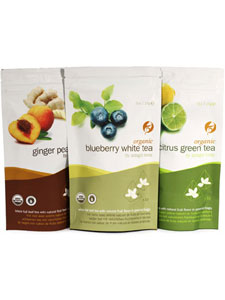
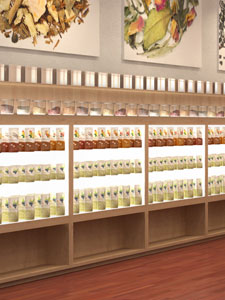
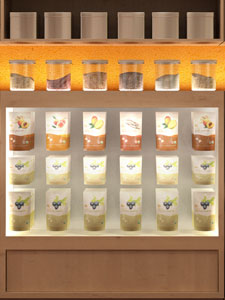
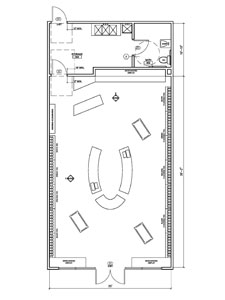
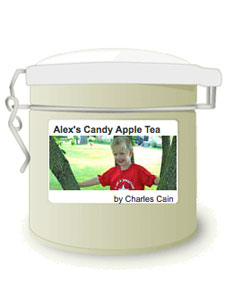
In Part 1 of this article I covered a few of the strategic elements that must be considered when designing a retail store. Part 2 described the objective of Adagio's move into physical retail stores. In this installment I'll share a number of tactical strategies that we've developed to create an environment so rich and compelling that all other tea shops seem boring in comparison. It's a lofty goal, but that's the point of having a dream!
Strategy #1: Efficient Packaging
A while back Adagio developed custom boxes for our pyramid tea bags and some pretty cool tins with clear, UV coated lids for loose leaf teas. These served us well, but we ran into issues of price and efficiency. (Read more about our packaging experiences and solutions in Packaging and Pricing for Wholesale.) In an effort to keep tea quality high and prices low, we invested heavily in the packaging equipment necessary to put all of our teas in resealable foil pouches. These pouches will be filled and sealed in our main distribution center.
Each tea will be available in 4oz standard pouches, 2oz sample pouches, and, for most teas, a pouch filled with pyramid tea bags for those who place a high priority on convenience. I wrote a piece on the topic of putting every tea in the collection in a tea bag in The future of the tea bag.
By supplying the store with shelf-ready packages of loose tea, complete with all necessary labeling information and bar codes, we can dramatically reduce the amount of time spent packaging tea at the customer's request and spend that time instead on consultative selling. The sealed pouches also are significantly less expensive (after the initial investment) than alternative packaging solutions, more environmentally friendly, and keep the tea fresher than bulk storage containers that are opened repeatedly to show, bag and brew tea. The ONLY downside to sealed tea containers is that the customer can't actually see or smell the tea. That's where Merchandising comes in.
Strategy #2: Simple, Accessible Merchandising
In order to encourage the customer to really EXPERIENCE the tea (sight, smell, even touch), we will put out a large sample jar of each tea in-line with the pre-sealed packages. While the glass jars expose the tea to light, and so are not ideal for long-term storage, these teas will never be sold or consumed anyway. They are for sample purposes only and will be disposed of and replaced periodically. For what it's worth, we also did some research and found that borosilicate glass blocks 90% of UV light (the kind that affects the tea). We've selected jars made from this material to minimize exposure.
Granted, sample jars are not a new invention, but the size of the jars and the arrangement will be unique. By grouping the teas by type (black, green, oolong) and arranging them in-line along the walls, the customer will more easily be able to browse visually through the entire collection without getting lost amidst the maze of look-alike products. (Note: the pouches will also be color coded to differentiate each type of tea.) This will take up a lot of space, but we intend to open a TEA SHOP, not a teapot shop. After all, It's about the TEA!
Because we want to be able to brew any tea in the building and allow the customers to create their own custom blends (more on these in a moment), we needed to also have each tea available in bulk storage. The silver boxes pictured above the sample jars will hold up to one pound of tea.
Strategy #3: Convenience AND Consultation
In a specialty tea shop it is critically important to support both customers who prefer to browse on their own (convenience) and also customers who require staff assistance (consultation). One of our larger competitors has their store set up in such a way that the ONLY way you can actually see or smell the tea is to talk to a sales associate who proceeds to hard sell you on this benefit or that. I find this terribly offensive and annoying, and I am convinced that it hurts their overall sales and customer satisfaction. I want to create an environment where nearly all of the teas are available on the floor with enough information to allow the customer to browse themselves, but ALSO make an interactive consultation session easy and comfortable.
The ONLY products in the entire store (tea or accessories) that cannot be viewed and handled by the customer without staff involvement will be the 10-15 teas in Adagio's new Master's Collection of premium loose leaf teas. These teas will retail for between $20 and $40 (sometimes more) for a 2oz package. These teas will be custom packaged in tins and will be available for sampling at the discretion of the staff.
To create a comfortable consultation environment (away from the packaged tea and so out of the way of other shoppers), we've designed a center island with counters that will range between 10 and 15 feet long. These counters will allow our tea consultants to spend time viewing, discussing, cupping and/or blending teas with individual or groups of customers. (NOTE: the sample floor plan pictured to the right is approximately 25' wide by 50' long for a total of 1,250 square feet including the back room. I'd rather not lease a space smaller than this.)
Strategy #4: Free Cupping and Tea Bar
We will of course offer samples of tea (a handful of pre-brewed favorites for customers to taste while browsing), but that's not exactly a unique strategy. To help break down the barriers of customer uncertainty and create a sensory rich experience, we plan to encourage free cupping of our teas. What better way is there to explain to a novice tea drinker the difference between an Assam, Ceylon, Keemun and Darjeeling than to brew them up side by side and taste the rainbow? As importantly, there is no better way to appeal to the connoisseur than to allow a side-by-side professional cupping of each of our Japanese green teas. The product costs are minimal, and while the labor costs (preparation, guidance, and clean-up) may be somewhat burdensome, that's the whole point of saving labor costs by pre-packing all the teas.
We'll also save labor costs and help the customers get more comfortable with brewing loose leaf tea by making the tea bar self-service. Instead of placing your order and waiting while a staff member brews your tea, you'll simply grab a paper tea filter and a teaspoon and choose any tea from among the bulk storage tins along the wall. This will also give our customers the opportunity to actually test our complete line of custom Adagio accessories and brewing equipment before buying. Any tea consumed on premises will be free. If you'd like to take a cup to-go, we'll charge you on your way out just like we would with other merchandise. A self service tea bar will also allow connoisseurs to prepare their tea as they prefer, and will allow the adventurous to create their own blend of two or more of our existing teas. Which leads us to strategy #5...
Strategy #5: Custom Blends
One of the most popular recent developments in our online business has been the introduction of custom blends. By allowing the customers to create their own blends, assign their own names, and upload their own artwork, we've made what was a collection of 150 or so teas infinitely more interesting and more personal. I tried this out by making Alex's Candy Apple Tea (pictured to the right) as a gift for my 5 year old's pre-school teachers.
Translating this same process to the store also allows the customer to interact with the tea and PLAY. We want customer to spend time in the shop and have fun. Tea doesn't need to be stuffy and unapproachable - especially flavored teas! We'll use our copious counter space and possibly even a few rolling carts to allow customers to pull down a handful of bulk storage containers and test their hand at creating their own perfect blend of teas.
Strategy #6: Information Kiosks
Thanks to Adagio's website and 10 years in the online tea business, we have the advantage of more than 50,000 customer reviews of our teas and accessories. In some cases we even have video demonstrations. (Check out the 500+ customer reviews and the video for IngenuiTEA.) We'll put one or more information kiosks in each store to allow the customer to access this wealth of information. We'll also encourage price shopping. Our size, direct supply chain, and operational efficiencies give us some very nice advantages. ;)
I could continue, but these six strategies provide a good overview of the ways we intend to "create theater" and re-invent the tea shopping experience. (For more information on this concept read The Cost of Theater. I wrote this article a little over three months ago in an effort to get feedback on these and other strategies.)
Adagio Teas
Twitter: @AdagioRetail
